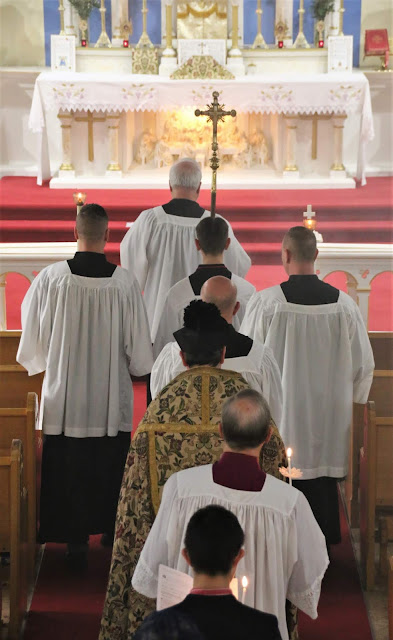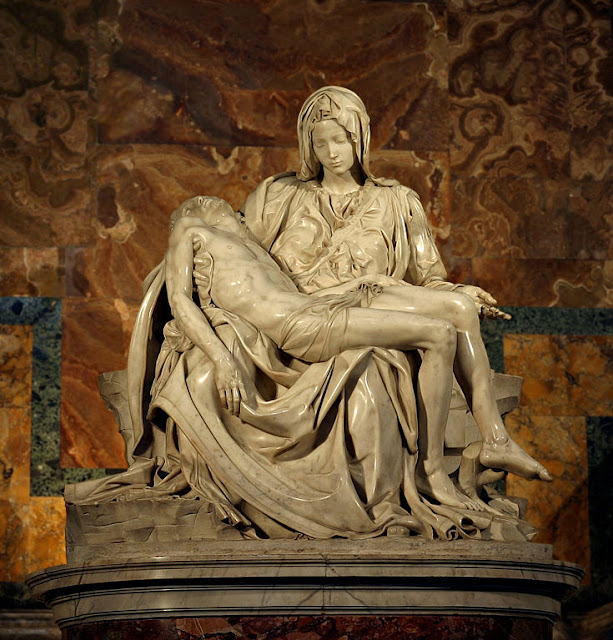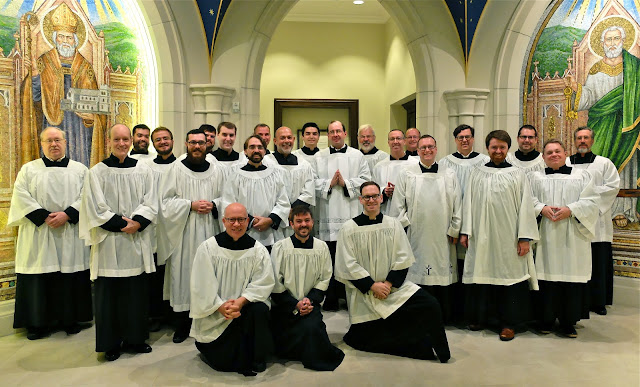One Parish: Four Communities; Three Forms.
 |
| Procession to High Altar, Our Lady Queen of Peace Parish |
The Parish of Our Lady Queen of Peace, Esquimalt, BC, is host to four communities worshiping according to three forms of the Mass.
Though there are clear and zealous preferences among parishioners for one of the three liturgical forms, parishioners navigate the busy times - high holy days - with a shared sense of accommodation and respect. Of course, this past Lent and Holy Week didn't present any management challenges given that there were no public Masses which would have required adaptation to avoid intersecting or overlapping liturgies. In past years, however, liturgical prescriptions have been observed in a way where each liturgical tradition finds expression. Priests and people have found ways to enact liturgies according to a schedule that serves each community and the common good.
N.B. - Dear non-Catholics reading this post, you are invited to embrace (or at least acknowledge) the Catholic understanding that holds the Mass in highest esteem. For it is in the sacred Liturgy that Catholics encounter Jesus: in Scripture; in the person of the priest acting in persona Christi; in the gathered assembly; and most sublimely in the Holy Eucharist, which is "the source and summit of the Christian life".
N.B. - Dear non-Catholics reading this post, you are invited to embrace (or at least acknowledge) the Catholic understanding that holds the Mass in highest esteem. For it is in the sacred Liturgy that Catholics encounter Jesus: in Scripture; in the person of the priest acting in persona Christi; in the gathered assembly; and most sublimely in the Holy Eucharist, which is "the source and summit of the Christian life".
The four communities which share the parish building are the:
- Ordinary Form in English
- Ordinary Form in Hungarian
- Latin Extraordinary Form
- Ordinariate or Divine Worship Form in Traditional English
- 1 & 2. The English and Hungarian communities worship using the Ordinary Form of the Mass, also known as the Mass of Pope Saint Paul VI. The Hungarian community meets once a month.
- 3. The Latin Mass community worships according to the 1962 Missal in use prior to the Second Vatican Council.
- 4. The Ordinariate community worships God according to Divine Worship: the Missal, promulgated in 2015, often called the Traditional English Mass because it uses a sacred form of English inherited from the venerable Anglican tradition. DW:TM incorporates elements from the Book of Common Prayer which, in its earliest form, was heavily in debt to the Sarum Use Mass.
The Hungarian, English (Ordinary Form) and Extraordinary Form communities belong to the Diocese of Victoria. Prior to the covid19 concern, diocesan Catholics regularly attended the Ordinariate's daily Divine Worship Mass
Mass Forms
The Ordinary Form (OF)
Most Catholics worship according to the Ordinary Form of the Mass, the form of the Mass promulgated in 1969 and published in 1970. This form retains the two principal parts of the Mass - the Liturgy of the Word and the Liturgy of the Eucharist - but is quite different from its predecessor, the Extraordinary Form or Tridentine Missal promulgated in 1570. The Ordinary Form is habitually prayed in the vernacular. The Extraordinary Form, with the exception of the homily, is entirely in Latin (with the Kyrie in Greek).
The Ordinary Form, as mentioned, is celebrated in the vernacular. This form of the Mass is typically celebrated versus populum, i.e., toward the people, though it it may be celebrated ad orientem like the EF and DW forms of the Mass. Because it is celebrated in the vernacular, this form of the Mass is usually filled with songs or hymns in English or Hungarian.
The Extraordinary Form (EF)
As mentioned, the EF Mass is almost entirely in Latin, the language of the Roman Church. Though promulgated in 1570, the EF Mass has undergone very little change since the earliest centuries. The changes that have occurred have been very modest. The EF Mass is prayed ad orientem, toward the Liturgical East, symbolized in most cases by the altar crucifix. Until the 1970s, Mass was prayed ad orientem for most of the Church's history.
At Queen of Peace, like-minded Catholics desiring the older form of the Mass have organized a small choir and a vibrant cohort of altar boys. The Latin Mass community has grown steadily since its inception due to the dedication of its lay leaders. Fr. Domotor celebrates the Mass, though on occasion priests from the Priestly Fraternity of Saint Peter (FSSP) celebrate Mass at Queen of Peace.
Divine Worship (DW)
The Ordinariate Mass, sometimes called the Traditional English Mass, is very similar in feel to the Latin Mass, and often times one will hear much Latin plainsong or chant in Divine Worship. The Ordinariate Form employs traditional English - thees and thous. The Our Father and Hail Mary prayers one commonly hears in the recitation of the Rosary are translated from the Latin using such elevated English. The language of Divine Worship, like Latin, is a sacral form of language reserved for the Liturgy.
The Ordinariate community of Saint John Henry Newman, formerly the Fellowship of Blessed John Henry Newman, was received into the Catholic Church through the assistance of diocesan priests, Fathers John Laszczyk and Dean Henderson, under the leadership of Cardinal Thomas Collins.
 |
| Fr. Laszczyk |
 |
| Fr. Henderson/VicNews |
Fr. Henderson, himself a former Anglican minister, and Fr. Laszczyk, Rector of Saint Andrew's Cathedral, guided the former Anglicans into communion through a one-of-a-kind process. Pope Benedict XVI initiated the reception of groups of Anglicans when he published the Apostolic Constitution Anglicanorum Coetibus, i.e., "Groups of Anglicans". The document paved the way for the formation of personal ordinariates which are like dioceses.The personal ordinariates, of which there are three - North America, the United Kingdom (England, Scotland and Wales) and Oceania (Australia, Japan, The Philippines and East Asia) - are transnational entities.
The Ordinariate community of Saint John Henry Newman had previously been hosted at Our Lady of Fatima Parish. The then Fellowship of Blessed John Henry Newman was pastored by Father (now Monsignor and Ordinary of the Personal Ordinariate of Our Lady of the Southern Cross) Carl Reid, assisted by Frs. Birch and Malins, and Monsignor Wilkinson, a former Bishop of the Anglican Catholic Church of Canada (ACCC).
After a change in leadership and priorities at Our Lady of Fatima Parish, the Ordinariate community was graciously welcomed to Queen of Peace parish by its pastor, Rev. Fr. John Domotor. The indefatigable Fr. Domotor celebrates Mass for three communities: the Ordinary Form in English; the Extraordinary Form in Latin; and the Ordinary Form in Hungarian.
 |
| MARPAC image |
After a change in leadership and priorities at Our Lady of Fatima Parish, the Ordinariate community was graciously welcomed to Queen of Peace parish by its pastor, Rev. Fr. John Domotor. The indefatigable Fr. Domotor celebrates Mass for three communities: the Ordinary Form in English; the Extraordinary Form in Latin; and the Ordinary Form in Hungarian.
Saint John Henry Newman community, which worships at Queen of Peace Parish, is currently led by Father Lee Kenyon, a former Anglican minister who led the Calgary Anglican community of Saint John the Evangelist into full communion with the Catholic Church.
End Note
The Holy See has recently distributed a survey to the world's bishops inquiring as to the situation in each bishop's diocese "with respect to the extraordinary form of the Roman Rite".
A Summary Comparison of the Three Forms of the Mass
 |
| Click on Image to Enlarge |
The Holy See has recently distributed a survey to the world's bishops inquiring as to the situation in each bishop's diocese "with respect to the extraordinary form of the Roman Rite".
Question #2 of the Survey asks - "If the extraordinary form is practiced there, does it respond to a true pastoral need or is it promoted by a single priest?"
Bishop Gordon could easily respond that, given a regular Sunday Extraordinary Form Mass attendance approaching the same numbers as the Ordinary Form Mass, there is most certainly "a true pastoral need" in the Diocese of Victoria for offering the Extraordinary Form Mass.
The Extraordinary Form community has been blessed with two vocations to the priesthood: a seminarian with the FSSP and another fellow with the ICKSP.
Question #5 of the Survey asks about the effect of the EF liturgy upon the OF Mass. One could respond that
- certainly the sense of decorum observed in both the Extraordinary Form and in the Ordinariate Mass have rubbed-off on the Ordinary Form liturgies. There is a strong sense among servers of all Masses that the Mass requires an appropriately organized and prayerful command of the roles and gestures that enable all to participate in a manner that is reverent and God-centred.
- A significant sign of the effect of the EF and DW liturgies upon the OF Mass is that weekday celebrations of the Ordinary Form are typically conducted ad orientem. And,
- more and more OF communicants continue to embrace communion-on-the-tongue habitually practiced in the EF and DW liturgies. Point-of-fact: prior to the covid19 concern, many diocesan Ordinary Form Catholics regularly attended the Ordinariate's daily Mass and received Holy Communion per the common Ordinariate practice of communion-on-the-tongue.
.jpg)





Comments
Post a Comment
Your comments will be appreciated and posted if 1) they are on topic and 2) preserve decorum.
Stand by your word.